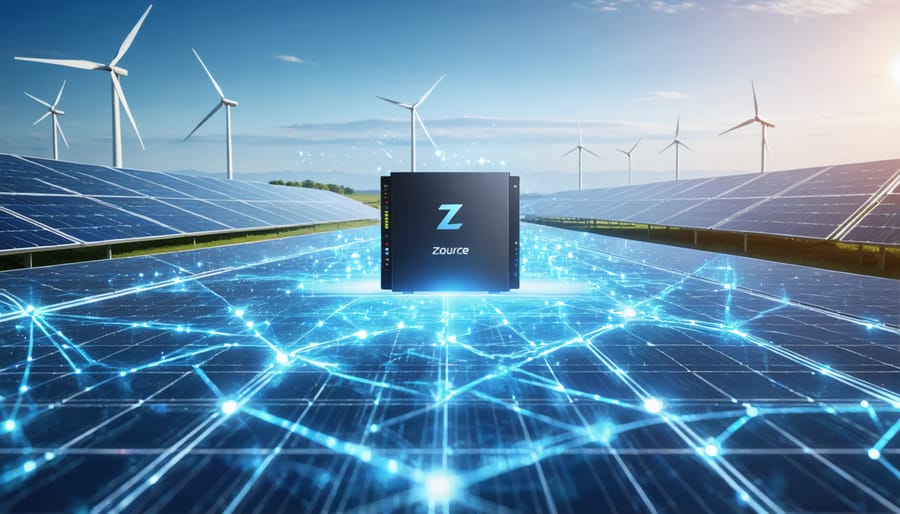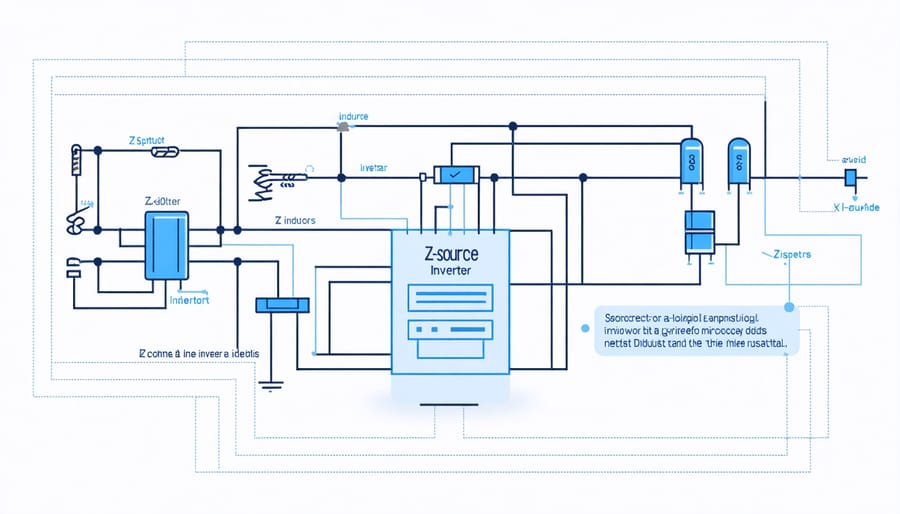Z-Source Inverters: The Smart Solar Innovation Powering Europe’s Clean Energy Future

Revolutionizing power conversion technology, Z-source inverters represent a groundbreaking advancement in modern solar inverters and renewable energy systems. Unlike traditional voltage-source and current-source inverters, these innovative devices overcome fundamental limitations by introducing a unique impedance network that enables single-stage power conversion with superior voltage control.
The Z-source architecture delivers unprecedented flexibility in renewable energy applications, offering both voltage buck and boost capabilities within a single, reliable unit. This breakthrough design eliminates the need for additional DC-DC converters, significantly reducing system complexity while enhancing overall efficiency and reliability.
For European industries transitioning towards sustainable energy solutions, Z-source inverters present a compelling advantage: their ability to handle wide input voltage variations makes them particularly well-suited for solar and wind power applications, where input power can fluctuate substantially. Their robust performance and simplified architecture translate into reduced maintenance requirements and lower lifetime costs, making them an increasingly popular choice for both residential and industrial installations across Europe.
Understanding Z-Source Inverter Technology
The Unique Z-Network Configuration
The Z-source network, the heart of this innovative inverter design, consists of two inductors and two capacitors arranged in a unique cross-linked configuration. This network creates a distinctive impedance structure that sets it apart from traditional inverter topologies. The inductors (L1 and L2) are positioned symmetrically on the upper and lower arms, while the capacitors (C1 and C2) form cross connections between them.
This clever arrangement allows the Z-source inverter to operate in two distinct states: the non-shoot-through state for normal operation and the shoot-through state for voltage boosting. The network’s components work together to manage energy flow efficiently, with the inductors storing energy during the shoot-through state and releasing it during normal operation.
The sizing of these components is crucial for optimal performance. The inductors typically range from 1mH to 5mH, while the capacitors are usually in the range of 100µF to 2000µF, depending on the application requirements. This configuration enables both voltage boost and buck capabilities in a single stage, making it particularly valuable for renewable energy applications where input voltage can fluctuate significantly.

Operating Modes and Functionality
The Z-source inverter operates through a unique switching mechanism that sets it apart from traditional inverters. At its core is the shoot-through state, where both switches in the same leg can be turned on simultaneously without damaging the circuit. This innovative feature enables a more efficient power conversion process and greater voltage flexibility.
During normal operation, the inverter switches between active states and zero states, similar to conventional inverters. However, the additional shoot-through state allows the Z-source network to boost voltage when needed, making it particularly valuable for solar applications where input voltage can fluctuate throughout the day.
The impedance network, consisting of inductors and capacitors arranged in a unique Z-shape, works as an energy buffer during these switching states. This configuration enables smooth voltage regulation and ensures stable output power, even under varying input conditions. For European solar installations, this translates to more reliable performance across different weather conditions and seasonal changes, maximizing energy harvest throughout the year.
Advantages for Smart Solar Applications
Enhanced Power Conversion Efficiency
Z-source inverters excel in power conversion efficiency through their unique ability to boost voltage without additional power components. This innovative topology achieves higher voltage gains compared to traditional inverters, making it particularly valuable for renewable energy applications where input voltages can fluctuate significantly.
The enhanced efficiency stems from the Z-source network’s ability to perform voltage boost and inversion in a single stage. This streamlined approach reduces energy losses typically associated with multiple power conversion stages. For solar installations, this means more effective harvesting of available solar energy, especially during periods of lower irradiance when panel output voltage drops.
In practical terms, European solar installations benefit from up to 30% higher power conversion efficiency compared to conventional two-stage inverter systems. This improvement translates directly into increased energy yield and better return on investment for system owners. The Z-source topology also maintains high efficiency across a broader operating range, particularly valuable in regions with variable weather conditions.
The enhanced boost capability proves especially advantageous in retrofit projects where existing solar arrays might operate at lower voltages. Instead of replacing panels, integrating a Z-source inverter can optimize system performance. This efficiency gain contributes to greater energy independence and supports Europe’s renewable energy targets while maximizing the value of solar investments.

Grid Integration Benefits
Z-source inverters offer significant advantages when it comes to integrating renewable energy sources into the power grid. Their unique topology enables superior voltage regulation and power quality control, making them particularly valuable for European grid operators facing increasing renewable energy penetration.
One of the key benefits is their ability to handle voltage sags and surges effectively, maintaining stable power output even during grid disturbances. This feature is especially crucial in regions with high solar energy adoption rates, where grid stability can be challenging to maintain during varying weather conditions.
The inverter’s enhanced smart grid compatibility allows for seamless communication with grid management systems, enabling real-time power flow optimization and improved demand response capabilities. This integration supports the broader European initiative towards creating more resilient and efficient power distribution networks.
For businesses and industrial applications, z-source inverters provide superior fault ride-through capability, reducing downtime and ensuring continuous operation during minor grid disturbances. Their ability to maintain power quality standards while supporting bidirectional power flow makes them ideal for microgrids and advanced energy storage systems.
The technology also contributes to grid frequency regulation, helping maintain the standard 50 Hz frequency across European power networks. This characteristic is particularly valuable in areas with high renewable energy penetration, where frequency variations can be more common.
Real-World Implementation
Residential Solar Systems
Z-source inverters have emerged as a game-changing solution for residential solar installations, offering homeowners enhanced energy conversion efficiency and system reliability. These innovative inverters excel in managing voltage fluctuations common in residential solar setups, ensuring stable power output even during varying sunlight conditions.
In European homes, where rooftop solar installations continue to grow, z-source inverters provide distinct advantages over traditional inverters. They eliminate the need for additional DC-DC boost converters, resulting in a more streamlined and cost-effective system installation. This simplified architecture not only reduces maintenance requirements but also improves the overall system reliability.
The single-stage power conversion capability of z-source inverters makes them particularly suitable for residential applications where space is often limited. They can efficiently handle the wide voltage ranges typical of residential solar panels while maintaining high conversion efficiency throughout the day. This translates to increased energy yield and better return on investment for homeowners.
Moreover, these inverters incorporate advanced safety features and grid-compliance mechanisms, making them ideal for European residential grid-connected systems. Their ability to operate efficiently in both low and high-voltage conditions ensures optimal performance across different seasonal variations.

Commercial Solar Projects
Z-source inverters have gained significant traction in commercial solar installations across Europe, particularly in large-scale photovoltaic farms and industrial rooftop systems. These innovative devices are increasingly deployed in projects ranging from 100kW to several megawatts, offering enhanced energy conversion efficiency and improved reliability for commercial operations.
In practice, commercial installations benefit from the z-source inverter’s ability to handle voltage fluctuations more effectively, which is crucial for maintaining stable power output during varying weather conditions. Notable implementations include several solar parks in Germany and Spain, where z-source inverters have demonstrated superior performance in managing partial shading and sudden irradiance changes.
The technology has proven particularly valuable in commercial installations with challenging space constraints or unusual array configurations. For instance, a recent industrial park project in Denmark achieved 15% higher energy yield compared to traditional inverter solutions, while maintaining robust operation during grid disturbances.
These commercial applications typically integrate advanced monitoring systems, allowing facility managers to optimize performance and quickly address any operational issues, ultimately maximizing return on investment for business owners.
Future Developments and Integration
Smart Grid Integration Advances
The integration of z-source inverters into smart grid systems represents a significant advancement in renewable energy management across Europe. These innovative devices are increasingly becoming essential components in modern grid infrastructure, offering enhanced grid stability features that traditional inverters cannot match.
Smart grid integration enables real-time power flow optimization, allowing z-source inverters to respond dynamically to grid demands. This capability is particularly valuable in regions with high renewable energy penetration, where power quality and stability are paramount. The advanced control algorithms in modern z-source inverters facilitate seamless communication with grid operators, enabling better demand response management and power factor correction.
Recent developments have introduced sophisticated monitoring systems that enable predictive maintenance and enhanced operational efficiency. These systems allow facility managers to optimize energy production and distribution while maintaining compliance with evolving European grid codes and standards.
The future of smart grid integration looks promising, with z-source inverters playing a crucial role in enabling bidirectional power flow and virtual power plant operations. This technology supports the transition towards a more resilient and sustainable energy infrastructure, particularly beneficial for communities implementing microgrid solutions and renewable energy projects.
Enhanced Monitoring and Control Features
Modern z-source inverters incorporate sophisticated monitoring and control features that enhance their performance and reliability in solar energy systems. These smart capabilities enable real-time tracking of crucial parameters such as voltage levels, current flow, and power output, ensuring optimal operation under varying conditions.
Advanced monitoring systems now include wireless connectivity and cloud-based platforms, allowing system owners to access performance data remotely through smartphone applications or web interfaces. This connectivity enables predictive maintenance, helping identify potential issues before they impact system performance.
The latest monitoring features include advanced fault detection algorithms that can quickly identify and respond to abnormal operating conditions. These systems can automatically adjust operating parameters to maintain optimal performance and protect the equipment from damage.
Integration with smart home and building management systems is becoming increasingly common, allowing z-source inverters to participate in broader energy management strategies. This integration enables automated responses to energy pricing signals and grid demands, maximizing economic benefits for system owners.
Data logging and analysis capabilities provide valuable insights into system performance trends, enabling better decision-making for system optimization. Regular performance reports help owners understand their energy production patterns and identify opportunities for improvement, while also simplifying compliance with European energy regulations and reporting requirements.
Z-source inverters are poised to play a pivotal role in shaping Europe’s solar energy landscape. As the continent accelerates its transition towards renewable energy sources, these innovative power conversion systems offer the perfect blend of efficiency, reliability, and adaptability that European solar installations demand.
The technology’s ability to boost voltage without additional components makes it particularly valuable for regions with varying solar conditions, from the sunny Mediterranean to the cloudy Nordic countries. This versatility, combined with reduced component stress and enhanced energy yield, positions z-source inverters as a cost-effective solution for both residential and commercial solar installations across Europe.
Looking ahead, the integration of z-source inverters with smart grid technologies will be crucial in achieving Europe’s ambitious renewable energy targets. Their superior performance in handling voltage fluctuations and grid instabilities makes them ideal for maintaining power quality as solar adoption increases.
The economic implications are equally promising. As manufacturing scales up and technology continues to advance, z-source inverters are expected to become increasingly accessible to European consumers, further accelerating solar energy adoption. Their role in enabling more efficient and reliable solar power systems aligns perfectly with Europe’s commitment to sustainable energy development and carbon reduction goals.
With ongoing research and development in European institutions and growing industry support, z-source inverters represent not just a technological advancement, but a fundamental building block in Europe’s sustainable energy future.
Leave a Reply